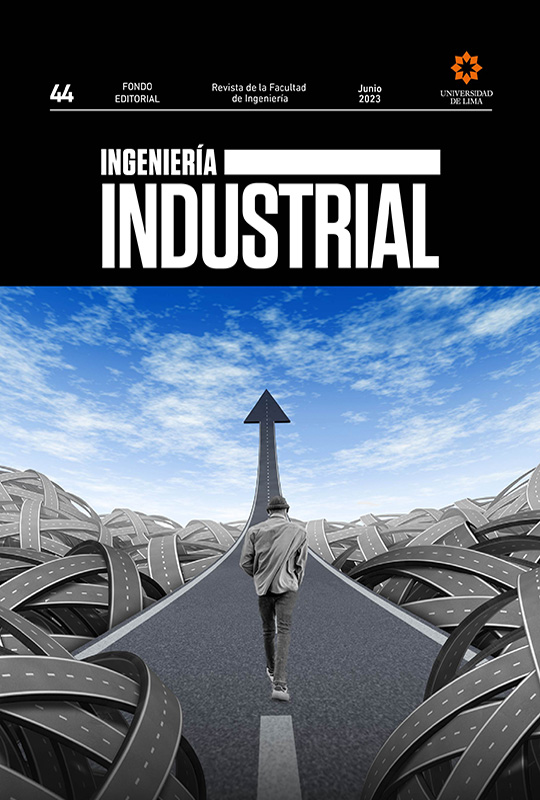Proceso de toma de decisiones para el pegado en piezas de calzado por medio de la metodología Analytic Hierarchy Process (AHP) y estadística
DOI:
https://doi.org/10.26439/ing.ind2023.n44.6130Palabras clave:
proceso analítico jerárquico, procesos de fabricación, toma de decisiones, industria del calzado, calzado, adhesivos, productividadResumen
En los procesos de manufactura continuamente existen condiciones para la toma de decisiones entre un conjunto de alternativas, comúnmente, la selección estará influenciada por aspectos críticos como calidad, productividad, costos, voz del cliente, entre otros. Este artículo presenta un análisis de los pegamentos utilizados en el pegado de piezas para calzado deportivo en una empresa ubicada en la ciudad de Purísima del Rincón en Guanajuato, México. El análisis se realiza con herramientas de ingeniería estadística y metodología del proceso analítico jerárquico (AHP por sus siglas en inglés). El caso de análisis trata de un problema que se presenta en el proceso de pegado de piezas, ya que, si bien el pegamento que se utiliza actualmente es de buena calidad, tiene algunos inconvenientes en cuanto a su alto costo y dificultad de aplicación, ya que debido a que es espeso y la aplicación manual requiere mucho tiempo, lo que afecta la productividad. Proponemos y aplicamos un modelo AHP con información de entrada obtenida por experimentación industrial para seleccionar la mejor alternativa. Los juicios objetivos y subjetivos están relacionados con el puntaje de calidad, la capacidad de producción, la facilidad de aplicación y la utilidad por par. La alternativa seleccionada representó la mejor opción considerando todos los aspectos de interés en el objetivo general.
Descargas
Referencias
Amaya, W. E., & Moreno, E. N. (2018). Reducción de tiempo en el proceso de mezclado de pegamento para calzado en un tanque agitador. Revisión de la literature científica [Reducing footwear adhesive mixing time in the mixing tank. A survey of the scientific literature]. Repositorio institucional de la Universidad Privada del Norte. https://repositorio.upn.edu.pe/handle/11537/24480
Calderón-Andrade, R., Hernández-Gress, E. S., & Montufar Benítez, M. A. (2020). Productivity Improvement through Reengineering and Simulation: A Case Study in a Footwear-Industry. Applied Sciences, 10(16), 5590. https://doi.org/10.3390/APP10165590
INEGI (Instituto Nacional de Estadística y Geografía). (2013). Estadísticas a propósito de la industria del calzado [Statistics on the footwear industry]. https://www.inegi.org.mx/app/biblioteca/ficha.html?upc=702825095666
INEGI (Instituto Nacional de Estadística y Geografía). (2018). Estadísticas a propósito de la industria de la moda del vestido, el calzado y la joyería [Statistics on the clothing, footwear and jewelry fashion industry]. https://www.inegi.org.mx/app/biblioteca/ficha.html?upc=702825095666
Marcelo, M. T., Avila, G. V., Cruz, M. A., Prado, B. M., & Navarro, M. M. (2016). Process improvement and utilization of machines in the production area of a shoe manufacturing company. IEEE International Conference on Industrial Engineering and Engineering Management, 2016, December, 701–705. https://doi.org/10.1109/IEEM.2016.7797966
Markkanen, P. (2009). Shoes, glues, and homework: dangerous work in the global footwear industry. Retrieved March 1, 2022, from https://www.routledge.com/ShoesGlues-and-Homework-Dangerous-Work-in-the-Global-Footwear-Industry/Markkanen-Levenstein-Forrant-Wooding/p/book/9780415784375
Méndez, J. B., Cremades, D., Nicolas, F., Perez-Vidal, C., & Segura-Heras, J. V. (2021). Conceptual and Preliminary Design of a Shoe Manufacturing Plant. Applied Sciences, 11(22), 11055. https://doi.org/10.3390/APP112211055
Montgomery, D. C., & Runger, G. C. (2011). Applied statistics and probability for engineers. John Wiley & sons.
Orgilés- Calpena, E., Arán-Aís, F., Torró-Palau, A. M., & Sánchez, M. A. M. (2019). Adhesives in the footwear industry: A critical review. Reviews of Adhesion and Adhesives, 7(1), 69–91. https://doi.org/10.7569/RAA.2019.097303
Pagano, S., Russo, R., & Savino, S. (2020). A vision-guided robotic system for flexible gluing process in the footwear industry. Robotics and Computer-Integrated Manufacturing, 65, 101965. https://doi.org/10.1016/J.RCIM.2020.101965
Paiva, R. M. M., Marques, E. A. S., da Silva, L. F. M., António, C. A. C., & Arán-Ais, F. (2015). Adhesives in the footwear industry. Proceedings of the Institution of Mechanical Engineers, Part L: Journal of Materials: Design and Applications, 230(2), 357-374. http://Dx.Doi.Org/10.1177/1464420715602441
Pizzi, A., & Mittal, K. L. (2018). Handbook of adhesive technology. Taylor & Francis. https://www.routledge.com/Handbook-of-Adhesive-Technology/Pizzi-Mittal/p/book/9780367572396
Rodríguez Benites, J. M. (2016). Implementación de Lean Manufacturing para mejorar la calidad del producto en la empresa productora de “Calzado Lupita” S.A. [Implementing Lean Manufacturing to improve the product quality of manufacturer Calzado Lupita S.A.] Innovación en Ingeniería, 2(1), 1-10. http://revistas.ucv.edu.pe/index.php/innovacion/article/view/1725
Saaty, T. L. (1980). The Analytic Hierarchy Process. McGraw-Hill Book Company. Xie, Y., & Li, J. (2016). Path planning based on robot posture control in spraying. Chinese Control Conference, CCC, 2016, August, 6098-6102. https://doi.org/10.1109/CHICC.2016.7554314
Zeng, H., & Li, J. (2015). Point cloud registration in shoe glue spraying line. Chinese Control Conference, CCC, 2015, September, 5691-5695. https://doi.org/10.1109/CHICC.2015.7260528











